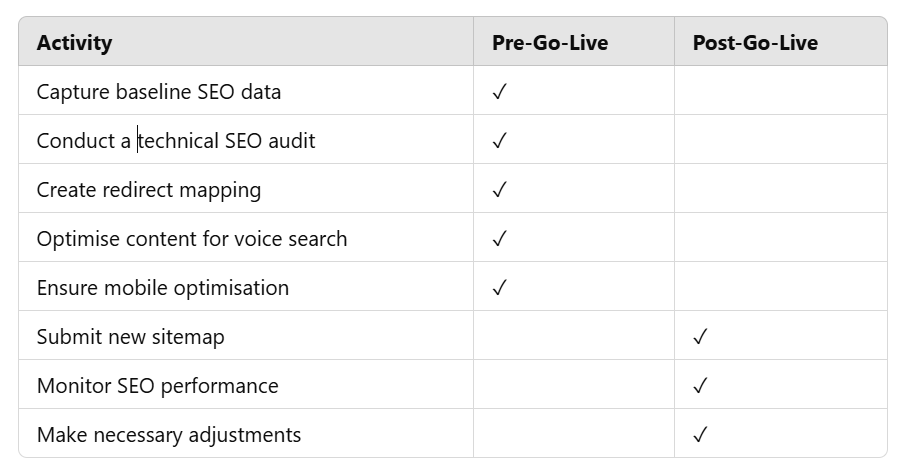Replatforming Your Website: Safeguarding Your Organic SEO
Replatforming your website can open new opportunities for growth, user experience, and scalability. However, without a well-thought-out plan, it can seriously harm your organic SEO, leading to traffic loss and decreased visibility. In this guide, we'll explore how to protect and even improve your organic SEO during a website replatforming process, with actionable steps to ensure a smooth transition.
Key Takeaways:
Prepare by capturing at least a month's worth of SEO data before replatforming.
Ensure technical SEO elements such as schema markup and mobile-friendliness are in place.
Conduct a thorough audit for duplicate content and broken links.
Optimise content for voice search by focusing on simple, question-based language.
Post-launch monitoring is crucial to tweak and improve performance.
Why SEO Matters During Replatforming
When replatforming, search engines need to re-crawl and index your new website. If critical elements aren't preserved, you risk losing rankings, traffic, and ultimately, revenue. The key is to manage the transition effectively by keeping SEO at the forefront of the process.
Your Step-by-Step Guide to Protecting Your SEO During Replatforming
1. Pre-Replatforming Preparation
1.1 Capture Baseline Data
Before making any changes, it's essential to collect a snapshot of your current performance. Use tools like Google Analytics and Google Search Console to gather insights on:
Organic traffic trends
Ranking keywords
Top-performing pages
Bounce rates and conversion metrics
Backlink profile
By having this data on hand, you'll be able to compare pre- and post-launch performance and spot any significant changes that might need addressing. Don’t forget to include Mobile and Desktop data to give you an understanding on how you’re performing across these different device.
1.2 Conduct a Comprehensive Audit
A full website audit will help identify potential risks and areas for improvement. Use free tools like Screaming Frog to crawl your website and check for:
Duplicate content, which can confuse search engines and dilute ranking potential.
Broken links that can harm user experience and SEO.
Missing meta tags and descriptions that provide context for search engines.
Create a priority order based on the issues Screaming Frog suggests, helping you to form an approach to the outcomes of your audit. You can use the Mobile Friendly Test to determine what fixes your new site needs to consider.
Remember, any missing information you have is important to consider for your new website. Writing meta descriptions, titles and alt tags that are compelling will be key.
1.3 Plan Redirect Mapping
Redirecting old pages to new ones ensures that search engines and users can still find important content. A well-structured redirect plan reduces 404 errors and preserves link equity. Tools like Redirection (for WordPress) can help simplify the process.
Steps to follow:
Map out old URLs to new URLs in a spreadsheet.
Implement 301 redirects to guide users and search engines.
Test redirects before launch to avoid errors.
2. Technical SEO Considerations
2.1 Implement Schema Markup
Schema markup helps search engines understand your content better and display rich results (e.g., product prices, star ratings). Use the Google Structured Data Markup Helper to generate schema for:
Product pages
Reviews
FAQs
2.2 Ensure Mobile-Friendliness
With Google's mobile-first indexing, your site must perform well on mobile devices. Use Google's Mobile-Friendly Test to check and improve:
Responsive design
Page speed (via PageSpeed Insights)
Optimising images and minimising unnecessary scripts
3. Content Optimisation for Voice Search
3.1 Simplify Language and Structure
Voice search users often ask direct questions, so it's essential to write content in a natural, easy-to-understand way. Use tools like AnswerThePublic to discover what people are searching for and structure your content to answer:
"How do I replatform my website without losing SEO?"
"What is the best way to optimise my website for voice search?"
3.2 Focus on Long-Tail Keywords
Voice search queries tend to be longer and more conversational. Tools like Ubersuggest can help you identify relevant phrases that align with user intent.
4. Post-Go-Live Monitoring
4.1 Track Performance Metrics
Once your new site is live, it's crucial to monitor performance and adjust where needed. Use Google Search Console and SEMrush to track:
Organic traffic changes
Keyword rankings
Crawl errors and indexing issues
4.2 Submit an Updated Sitemap
Help search engines crawl and index your site by submitting an updated XML sitemap via Google Search Console. Tools like XML-Sitemaps can generate one for you.
4.3 Ongoing Tweaks and Improvements
SEO is an ongoing effort that needs regular adjustments based on new insights. Review your analytics monthly to:
Optimise underperforming pages
Fix broken links and errors
Update content based on emerging trends
Additional Best Practices for 2025
Consider these additional steps to future-proof your SEO:
Core Web Vitals: Focus on page experience metrics like loading speed, interactivity, and visual stability.
User Experience (UX): Ensure intuitive navigation and accessibility.
E-E-A-T: Enhance Expertise, Experience, Authority, and Trustworthiness.
Action Plan for Replatforming Success
Conclusion
Replatforming your website is an exciting opportunity to modernise and enhance your online presence. However, ensuring your organic SEO remains intact requires thorough planning and ongoing vigilance. By taking proactive steps before and after launch, you can minimise disruptions, maintain rankings, and continue growing your business online.



